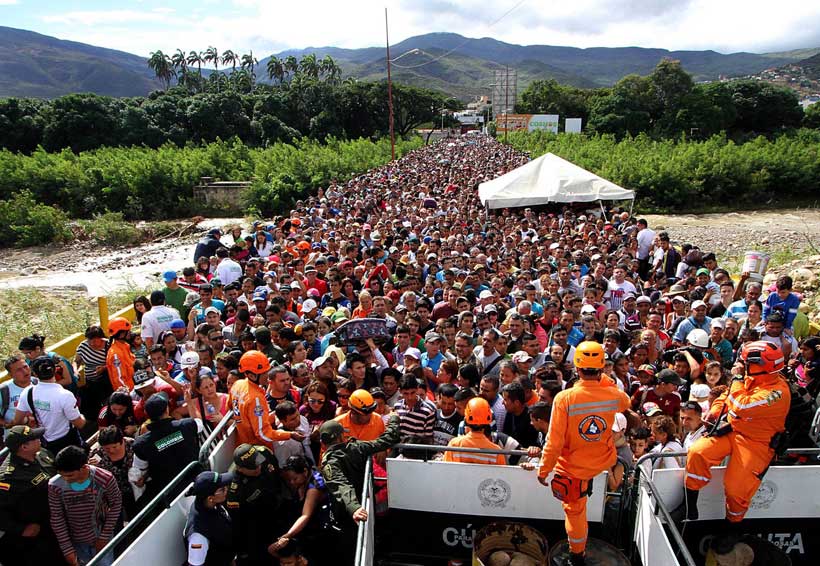The Simón Bolívar International Bridge linking Venezuela and Colombia has long ceased to be a mere bridge. For months, the thousands who cross this bridge daily have transformed it into a symbol of the Venezuelan exodus. Many kilometers to the north of the Latin American region, human caravans from Central America’s Northern Triangle once again placed the spotlight on another longstanding migration issue.
Although they come from different places, those embarking on these journeys face the same situation—they are leaving their homes because of a lack of opportunities, violence, or even food shortages. Occurring at a hitherto unseen speed and magnitude, this phenomenon has created an unprecedented migration crisis for Latin America and the Caribbean. What are the characteristics of each?
Migration from Venezuela involves one of the biggest and most rapid flows of vulnerable persons globally. According to the United Nations Refugee Agency (UNHCR), as of February 2019, the country’s economic and social crisis had led to the exodus of 3.4 million persons. Most have left in the past 12 months and have gone to Colombia, Peru, Ecuador and Chile, the main receiving countries. The magnitude of this crisis makes it the second biggest globally after the Syrian crisis.
The movement of persons from the Northern Triangle to the United States has been taking place for a much longer time. Between 1980 and 2015, the number of migrants from this subregion who were living in the United States increased by an annual average of 8 percent and in 2017, their total number in the United States stood at close to 3 million. Most persons leave because of the shortage of good jobs, high rates of crime and violence, and the desire to be reunited with their families. Remittances to Honduras, Guatemala, and El Salvador, which amounted to almost US$20 billion in 2017, have become one of the main pillars of their economies, accounting for nearly 15 percent of their combined GDPs.
With the movement of persons come challenges and opportunities for both the source and destination areas, as I mentioned last week at the conference “Migration and Cities. The Path to Inclusive Integration,” held in Madrid.
According to a World Bank report published last November, the cost of additional education, health, water, early childhood, humanitarian, employment, and institution building services resulting from migration from Venezuela is estimated at between 0.2 percent and 0.4 percent of Colombia’s GDP, a figure that will certainly increase given the growing number of persons leaving Venezuela. Despite this, the countries of Latin America and the Caribbean have opened their doors to migrants in a gesture of solidarity commensurate with the magnitude of the crisis. In terms of opportunities, migration can create economic growth when it is well managed.
As happens in other regions, Northern Triangle migration breaks family and community ties and disrupts the support networks in the originating countries. It can, however, contribute to poverty reduction, human capital improvement, and greater investment as a result of the transfer of remittances. El Salvador provides the most compelling evidence of this, where it is estimated that in 2014 the poverty rate would have been 12 percent higher without those remittances. Another analysis conducted in Guatemala using data from that same year demonstrated that the likelihood that a family would face food insecurity decreases by 40 percent when it receives remittances.
At the World Bank, we are supporting the region using the experience gained in other areas of the world such as the Horn of Africa or the Middle East. We are assisting Colombia by analyzing the effects of migration and short- and medium-term response strategies. Similar studies involving Peru and Ecuador are also being carried out. In addition, we recently announced Colombia’s eligibility for funding from the Global Concessional Financing Facility, a platform that supports countries hosting large numbers of refugees. Furthermore, the refugee issue will be one of the main topics discussed at the upcoming Spring Meetings of the World Bank and International Monetary Fund, to take place in less than three weeks. Going forward, we will continue our commitment by providing technical and financial assistance to migrant-receiving countries.
In the Northern Triangle, we are helping to improve access to health and education, boost the competitiveness and productivity of small producers, and enhance food security in areas impacted by drought and climate change such as the Dry Corridor, while at the same time assisting with crime and violence prevention and conducting analyses of key issues such as job creation. The aim of all these activities is to provide persons seeking a brighter future with options other than fleeing to another country.
Our efforts complement the work being done by other development organizations, governments, and civil society, although they will have to be redoubled given the projected continuation of these migration flows. The only way we will be able to tackle what is likely the greatest humanitarian crisis facing Latin America and the Caribbean today is through commitment and genuine solidarity with persons facing the dual vulnerabilities of poverty and migration.


